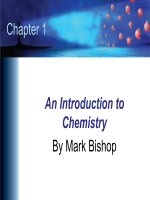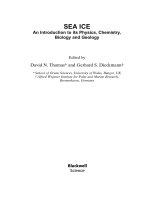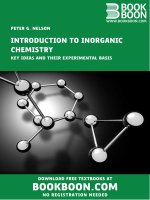Introduction to pharmaceutical analytical chemistry
Bạn đang xem bản rút gọn của tài liệu. Xem và tải ngay bản đầy đủ của tài liệu tại đây (13.99 MB, 547 trang )
❦
Introduction to
Pharmaceutical
Analytical Chemistry
❦
❦
❦
❦
❦
❦
❦
❦
Introduction to
Pharmaceutical
Analytical Chemistry
❦
STIG PEDERSEN-BJERGAARD
Department of Pharmacy, University of Oslo, Norway and
Department of Pharmacy, University of Copenhagen, Denmark
BENTE GAMMELGAARD
Department of Pharmacy, University of Copenhagen, Denmark
TRINE GRØNHAUG HALVORSEN
Department of Pharmacy, University of Oslo, Norway
Second Edition
❦
❦
❦
This edition first published 2019
© 2019 John Wiley & Sons Ltd
Edition history:
“John Wiley & Sons Ltd. (1e, 2012)”.
All rights reserved. No part of this publication may be reproduced, stored in a retrieval system, or transmitted, in any form or by
any means, electronic, mechanical, photocopying, recording or otherwise, except as permitted by law. Advice on how to obtain
permission to reuse material from this title is available at />The right of Stig Pedersen-Bjergaard, Bente Gammelgaard and Trine Grønhaug Halvorsen to be identified as the authors of the
editorial material in this work has been asserted in accordance with law.
Registered Offices
John Wiley & Sons, Inc., 111 River Street, Hoboken, NJ 07030, USA
John Wiley & Sons Ltd, The Atrium, Southern Gate, Chichester, West Sussex, PO19 8SQ, UK
Editorial Office
The Atrium, Southern Gate, Chichester, West Sussex, PO19 8SQ, UK
For details of our global editorial offices, customer services, and more information about Wiley products visit us at
www.wiley.com.
Wiley also publishes its books in a variety of electronic formats and by print-on-demand. Some content that appears in standard
print versions of this book may not be available in other formats.
❦
Limit of Liability/Disclaimer of Warranty
In view of ongoing research, equipment modifications, changes in governmental regulations and the constant flow of information
relating to the use of experimental reagents, equipment and devices, the reader is urged to review and evaluate the information
provided in the package insert or instructions for each chemical, piece of equipment, reagent or device for, among other things,
any changes in the instructions or indication of usage and for added warnings and precautions. While the publisher and authors
have used their best efforts in preparing this work, they make no representations or warranties with respect to the accuracy or
completeness of the contents of this work and specifically disclaim all warranties, including without limitation any implied
warranties of merchantability or fitness for a particular purpose. No warranty may be created or extended by sales
representatives, written sales materials or promotional statements for this work. The fact that an organization, website or product
is referred to in this work as a citation and/or potential source of further information does not mean that the publisher and authors
endorse the information or services the organization, website or product may provide or recommendations it may make. This
work is sold with the understanding that the publisher is not engaged in rendering professional services. The advice and
strategies contained herein may not be suitable for your situation. You should consult with a specialist where appropriate.
Further, readers should be aware that websites listed in this work may have changed or disappeared between when this work was
written and when it is read. Neither the publisher nor authors shall be liable for any loss of profit or any other commercial
damages, including, but not limited to, special, incidental, consequential or other damages.
Library of Congress Cataloging-in-Publication Data
Names: Pedersen-Bjergaard, Stig, author. | Gammelgaard, Bente, author. |
Halvorsen, Trine G. (Trine Grønhaug), 1975- author.
Title: Introduction to pharmaceutical analytical chemistry / Stig
Pedersen-Bjergaard, Department of Pharmacy, University of Oslo, Norway and
Department of Pharmacy, University of Copenhagen, Denmark, Bente
Gammelgaard, Department of Pharmacy, University of Copenhagen,
Denmark,Trine Grønhaug Halvorsen, Department of Pharmacy, University of Oslo,
Norway.
Other titles: Introduction to pharmaceutical chemical analysis.
Description: Second edition. | Hoboken, NJ : Wiley, 2019. | Revision of:
Introduction to pharmaceutical chemical analysis / Steen Hansen, Stig
Pedersen-Bjergaard, Knut Rasmussen. 2012. | Includes bibliographical
references and index. |
Identifiers: LCCN 2018051420 (print) | LCCN 2018053744 (ebook) | ISBN
9781119362739 (Adobe PDF) | ISBN 9781119362753 (ePub) | ISBN 9781119362722
(paperback)
Subjects: LCSH: Drugs–Analysis. | Pharmaceutical chemistry. | BISAC: SCIENCE
/ Chemistry / Analytic.
Classification: LCC RS189 (ebook) | LCC RS189 .H277 2019 (print) | DDC
615.1/9–dc23
LC record available at />Cover design: Wiley
Cover Images: © Background © REB Images/Getty Images,
Testing image © TEK IMAGE/SCIENCE PHOTO LIBRARY/Getty Images,
Research image © TEK IMAGE/SCIENCE PHOTO LIBRARY/Getty Images,
Formula © ALFRED PASIEKA/SCIENCE PHOTO LIBRARY/Getty Images
Set in size of 10/12pt and TimesLTStd by SPi Global, Chennai, India
10 9 8 7 6 5 4 3 2 1
❦
❦
Contents
Preface to the Second Edition
Abbreviations
Symbols and Units
1 Introduction to Pharmaceutical Analytical Chemistry
1.1
Introduction
1.2
Pharmaceutical Analytical Chemistry
1.2.1
A Brief Definition
1.2.2
Manufacture of Pharmaceuticals
1.2.3
Development of New Drugs
1.2.4
Use of Pharmaceuticals
1.3
This Textbook
xv
xvii
xxi
1
1
4
4
4
6
6
7
2 Marketing Authorizations, Pharmaceutical Manufacturing,
and International Pharmacopoeias
2.1
Introduction
2.2
Marketing Authorization and Industrial Production
2.3
Pharmacopoeias
2.4
Life Time of Pharmaceutical Preparations and Ingredients
9
9
10
13
14
3 Fundamentals of Bases, Acids, Solubility, Polarity, Partition, and
Stereochemistry
3.1
Acids, Bases, pH, and pKa
3.2
Buffers
3.3
Acid and Base Properties of Drug Substances
3.4
Distribution Between Phases
3.5
Stereoisomers
3.6
Active Pharmaceutical Ingredients – A Few Examples
3.6.1
Fluoxetine – A Basic and Lipophilic Drug
3.6.2
Atenolol – A More Polar Basic Drug
3.6.3
Morphine – A Zwitterionic Drug (Base and Acid)
3.6.4
Ibuprofen – An Acidic Drug
3.6.5
Paracetamol – A Weak Acid
3.6.6
Hydrocortisone – A Neutral Drug
3.7
Stability of Drug Substances
17
17
19
20
21
26
28
28
29
30
31
33
34
34
vi
Contents
4 Fundamentals of Pharmaceutical Analytical Chemistry
4.1
Pharmaceutical Analytical Chemistry
4.2
How to Specify Quantities, Concentrations, and Compositions of
Mixtures
4.3
Laboratory Equipment
4.3.1
The Analytical Balance
4.3.2
Pipettes
4.3.3
Volumetric Flasks
4.3.4
Burettes
4.4
How to Make Solutions and Dilutions
4.5
Errors, Accuracy, and Precision
4.5.1
Systematic and Random Errors
4.5.2
Accuracy and Precision
4.6
Statistical Tests
4.6.1
Mean Value and Standard Deviation
4.6.2
Confidence Intervals
4.6.3
Comparison of Standard Deviations with the F-Test
4.6.4
Comparison of Means with a t-Test
4.6.5
Q-Test to Reject Outliers
4.7
Linear Regression Analysis
4.8
How to Present an Analytical Result
4.9
Additional Words and Terms
37
37
39
43
43
47
50
51
52
54
54
55
56
56
58
58
60
64
65
68
70
5 Titration
5.1
Introduction
5.2
Potentiometric Titration and Electrodes
5.3
Aqueous Acid–Base Titrations
5.4
Titration in Non-aqueous Solvents
5.5
Redox Titrations
5.6
Alternative Principles of Titration
73
73
79
82
88
91
95
6 Introduction to Spectroscopic Methods
6.1
Electromagnetic Radiation
6.2
Molecules and Absorption of Electromagnetic Radiation
6.3
Absorbing Structures – Chromophores
6.4
Fluorescence
6.5
Atoms and Electromagnetic Radiation
97
97
99
101
101
102
7 UV-Vis Spectrophotometry
7.1
Areas of Use
7.2
Quantitation
7.3
Absorbance Dependence on Measurement Conditions
7.4
Identification
105
105
106
108
110
Contents
7.5
vii
Instrumentation
7.5.1
Radiation Sources
7.5.2
Monochromator
7.5.3
Sample Containers
7.5.4
Detectors
7.5.5
Single-Beam and Double-Beam Instruments
Practical Work and Method Development
Test of Spectrophotometers
7.7.1
Control of Wavelengths
7.7.2
Control of Absorbance
7.7.3
Limit of Stray Light
7.7.4
Resolution (for Qualitative Analysis)
7.7.5
Spectral Slit-Width (for Quantitative Analysis)
Fluorimetry
111
112
112
113
114
114
115
116
117
117
118
119
119
119
8 IR Spectrophotometry
8.1
IR Spectrophotometry
8.2
Instrumentation
8.3
Recording by Transmission, Diffuse Reflectance, and Attenuated
Total Reflection
8.4
Instrument Calibration
8.5
NIR Spectrophotometry
121
121
125
9 Atomic Spectrometry
9.1
Applications of Atomic Spectrometry
9.2
Atomic Absorption Spectrometry (AAS)
9.3
AAS Instrumentation
9.3.1
Radiation Sources
9.3.2
Sample Introduction System
9.3.3
Sample Atomizer
9.3.4
Monochromator
9.3.5
Electrothermal Atomizer
9.3.6
Interferences
9.3.7
Background Correction
9.4
AAS Practical Work and Method Development
9.5
Atomic Emission Spectrometry (AES)
9.6
Flame Photometry
9.7
Inductively Coupled Plasma Emission Spectrometry
9.8
Inductively Coupled Plasma Mass Spectrometry
131
131
132
132
133
133
134
135
135
136
137
137
138
139
140
141
7.6
7.7
7.8
10 Introduction to Chromatography
10.1 Introduction
10.2 General Principles
125
128
129
143
143
144
viii
Contents
10.3
10.4
10.5
10.6
10.7
10.8
Retention
Efficiency
Selectivity
Resolution
Peak Symmetry
The Dynamics of Chromatography
146
149
151
152
154
155
11 Separation Principles in Liquid Chromatography
11.1 Introduction
11.2 Reversed-Phase Chromatography
11.2.1 Stationary Phases
11.2.2 Retention Mechanisms
11.2.3 Mobile Phases
11.3 Ion-Pair Chromatography
11.4 Normal-Phase Chromatography
11.4.1 Silica and Related Stationary Phases
11.4.2 Molecular Interactions and Retention
11.4.3 Mobile Phases
11.5 Thin-Layer Chromatography
11.6 Hydrophilic Interaction Chromatography
11.7 Ion Exchange Chromatography
11.8 Size Exclusion Chromatography
11.9 Chiral Separations
11.10 Supercritical Fluid Chromatography
159
159
160
160
162
164
168
170
171
172
173
173
175
177
178
180
182
12 High Performance Liquid Chromatography
12.1 Introduction
12.2 The Column
12.3 Scaling Between Columns
12.4 Pumps
12.5 Injectors
12.6 Detectors
12.6.1 UV Detectors
12.6.2 Fluorescence Detectors
12.6.3 Electrochemical Detectors
12.6.4 Refractive Index, Evaporative Light Scattering,
and Charged Aerosol Detectors
12.7 Mobile Phases
12.8 Solvents for Sample Preparation
185
185
186
188
189
191
192
193
195
196
13 Gas Chromatography
13.1 Introduction
13.2 Basic Principle
199
199
200
197
197
198
Contents
13.3
13.4
13.5
13.6
13.7
13.8
13.9
13.10
Instrumentation
Carrier Gas
Stationary Phases
Retention
Columns
Injection
Detectors
Derivatization
ix
201
203
205
207
208
209
211
213
14 Electrophoretic Methods
14.1 Introduction
14.2 Principle and Theory
14.3 Gel Electrophoresis
14.4 SDS-PAGE
14.5 Western Blotting
14.6 Isoelectric Focusing
14.7 Capillary Electrophoresis
14.7.1 Principle and Instrumentation
14.7.2 Electro-osmotic Flow and Mobility
14.7.3 Dispersion
14.7.4 Capillaries
14.7.5 Sample Introduction
14.7.6 Detection
14.7.7 Applications
215
215
216
218
220
221
223
223
223
224
226
228
228
229
229
15 Mass Spectrometry
15.1 Introduction
15.2 Basic Theory of Mass Spectrometry
15.3 Ionization
15.4 The Mass Spectrometer as a Chromatographic Detector – Data
Acquisition
15.5 Quantitation by MS
15.6 Identification by MS
15.6.1 GC-MS and LC-MS
15.6.2 Structural Information from Isotopes
15.6.3 Structural Information from Fragmentation
15.6.4 Structural Information from Accurate Masses
(High Resolution MS)
15.6.5 Structural Information for Peptides and Proteins
15.7 Instrumentation
15.7.1 Ion Sources for GC-MS
15.7.2 Ion Sources for LC-MS
15.7.3 Single Quadrupole Analysers
231
231
233
235
236
238
238
238
240
242
247
249
251
251
252
254
x
Contents
15.7.4
15.7.5
15.7.6
15.7.7
15.7.8
Triple Quadrupole Analysers
Ion Trap Analysers
Time-of-Flight Analysers
High Resolution Instruments
Matrix-Assisted Laser Desorption/Ionization Mass
Spectrometry
255
256
257
258
258
16 Sample Preparation
16.1 When is Sample Preparation Required?
16.2 Main Strategies
16.3 Recovery and Enrichment
16.4 Liquid–Liquid Extraction
16.4.1 Procedure
16.4.2 Theory
16.4.3 Extraction Solvents
16.4.4 Parameters Affecting Extraction Recovery
16.4.5 Liquid–Liquid Extraction with Back-Extraction
16.5 Solid–Liquid Extraction
16.6 Solid Phase Extraction
16.6.1 Fundamentals
16.6.2 The Solid Phase Extraction Column
16.6.3 Conditioning
16.6.4 Equipment
16.6.5 Reversed-Phase Solid Phase Extraction
16.6.6 Secondary Interactions
16.6.7 Ion Exchange Solid Phase Extraction
16.6.8 Mixed-Mode Solid Phase Extraction
16.6.9 Normal-Phase Solid Phase Extraction
259
259
260
261
263
263
264
265
267
269
269
270
270
271
272
272
273
275
275
278
279
17 Quality of Analytical Data and Validation
17.1 Instrumental Signals
17.2 Calibration Methods
17.2.1 External Standard
17.2.2 One Point Calibration
17.2.3 Internal Standard
17.2.4 Standard Addition
17.2.5 Normalization
17.3 Analytical Procedures
17.4 Validation
17.4.1 Specificity
17.4.2 Accuracy
17.4.3 Precision
17.4.4 Detection Limit
17.4.5 Quantitation Limit
17.4.6 Linearity and Range
281
281
282
283
284
285
288
289
290
291
292
293
294
295
297
298
Contents
xi
17.4.7 Robustness
17.4.8 Test Methods in Ph. Eur. and USP
System Suitability
17.5.1 Adjustment of Chromatographic Conditions
300
300
301
301
18 Chemical Analysis of Pharmaceutical Ingredients
18.1 Pharmaceutical Ingredients, Production, and Control
18.2 Pharmacopoeia Monographs
18.3 Impurities in Pharmaceutical Ingredients
18.3.1 Impurities in Pure Chemical Ingredients
18.3.2 Impurities in Organic Multi-Chemical Ingredients
18.4 Identification of Pharmaceutical Ingredients
18.4.1 IR Spectrophotometry
18.4.2 UV-Vis Spectrophotometry
18.4.3 Thin-Layer Chromatography
18.4.4 Melting Point
18.4.5 Optical Rotation
18.4.6 Liquid Chromatography
18.4.7 Chloride and Sulfate Identification
18.5 Impurity Testing of Pharmaceutical Ingredients
(Pure Chemical Ingredients)
18.5.1 Appearance of Solution
18.5.2 Absorbance
18.5.3 pH and Acidity or Alkalinity
18.5.4 Related Substances
18.5.5 Residual Solvents
18.5.6 Foreign Anions
18.5.7 Sulfated Ash
18.5.8 Elemental Impurities
18.5.9 Loss on Drying
18.5.10 Water
18.6 Identification and Impurity Testing of Organic Multi-Chemical
Ingredients
18.6.1 Oxidizing Substances
18.6.2 Acid Value
18.6.3 Hydroxyl Value
18.6.4 Iodine Value
18.6.5 Peroxide Value
18.6.6 Saponification Value
18.6.7 Unsaponifiable Matter
18.6.8 Other Tests
18.7 Assay of Pharmaceutical Ingredients
18.7.1 Aqueous Acid–Base Titration
18.7.2 Non-Aqueous Acid–Base Titration
18.7.3 Redox Titrations
305
306
308
321
321
324
324
324
330
333
334
335
340
341
17.5
344
345
347
347
351
355
359
361
363
366
367
368
369
369
369
370
371
371
372
372
375
375
380
383
xii
Contents
18.8
18.7.4 Liquid Chromatography
18.7.5 UV-Vis Spectrophotometry
Chemical Analysis of Pharmaceutical Ingredients Not Included in
Pharmacopoeias
385
387
388
19 Chemical Analysis of Pharmaceutical Preparations
19.1 Chemical Analysis of Pharmaceutical Preparations
19.2 Monographs and Chemical Analysis
19.3 Identification of the API
19.3.1 Identification by IR Spectrophotometry
19.3.2 Identification by Liquid Chromatography
19.3.3 Identification by UV-Vis Spectrophotometry
19.4 Assay of the Active Pharmaceutical Ingredient
19.4.1 Assays Based on Liquid Chromatography
19.4.2 Assays Based on UV Spectrophotometry
19.4.3 Assays Based on Titration
19.5 Chemical Tests for Pharmaceutical Preparations
19.5.1 Test for Related Substances
19.5.2 Uniformity of Content
19.5.3 Dissolution
389
389
390
395
396
401
406
410
411
419
423
427
427
430
432
20 Bioanalysis Chemical Analysis of Pharmaceuticals in Biological Fluids
20.1 Bioanalysis
20.1.1 Drug Development
20.1.2 Therapeutic Drug Monitoring
20.1.3 Forensic and Toxicological Analysis
20.1.4 Doping Control Analysis
20.2 Biological Fluids
20.3 Bioanalytical Methods – An Overview
20.4 Sampling
20.5 Sample Preparation
20.5.1 Protein Precipitation
20.5.2 Liquid–Liquid Extraction
20.5.3 Solid-Phase Extraction
20.6 Separation and Detection
20.7 Quantitation
20.8 Screening
433
433
434
435
436
436
438
440
440
441
441
443
446
446
447
453
21 Chemical Analysis of Biopharmaceuticals
21.1 Biopharmaceuticals
21.1.1 Amino Acids, the Building Blocks of Biopharmaceuticals
21.1.2 Structure of Proteins
21.1.3 Glycosylation of Proteins and Peptides
21.2 Biopharmaceuticals versus Small Molecule APIs
21.3 Biopharmaceuticals and Pharmacopoeias
459
459
460
460
463
463
464
Contents
21.4
21.5
Production of Biopharmaceuticals
Identification Procedures for Biopharmaceuticals (Active Substance)
21.5.1 Peptide Mapping – Information About Primary Structure
21.5.2 Separation Techniques
21.5.3 Glycan Analysis
21.5.4 Other Techniques
21.6 Impurity Tests for Biopharmaceuticals (Active Substances)
21.6.1 Impurities with Differing Molecular Masses
21.6.2 Impurities with Different Charges/Charge Variants
21.6.3 Total Protein/Protein Content
21.6.4 Glycan Analysis
21.7 Assay of Biopharmaceuticals (Active Substance)
21.8 Monoclonal Antibodies
21.9 Analysis of Biopharmaceutical Products
21.10 Bioanalysis of Biopharmaceuticals Using LC-MS/MS
Index
xiii
465
467
468
476
482
488
488
489
491
495
497
498
500
502
503
505
Preface to the Second Edition
This textbook is an extensive revision of ‘Introduction to Pharmaceutical Analysis’ from
2012. We have revised the manuscript totally, and updated the content according to current
practice in pharmaceutical analytical chemistry, and according to current versions of European and United States Pharmacopeia. Additionally, we have added a new chapter on chemical analysis of biopharmaceuticals, improved the illustrations throughout and provided
illustrations in colour. The intention of these efforts has been to provide the reader with a
textbook at the level expected in 2018.
We have changed the title to emphasize that this textbook is about analytical chemistry,
and that the applications described are all related to pharmaceuticals. However, the philosophy is the same as with the first edition. The textbook is primarily for pharmacy and
chemistry students (and other scientists approaching the pharmaceutical sciences) at university level, requesting basic knowledge on chemical analysis of pharmaceutical ingredients
and preparations, and chemical analysis of drug substances in biological fluids. In the first
part of the textbook, we teach the fundamentals of the main analytical techniques. Compared to textbooks in pure analytical chemistry, we go into less detail but we still teach to a
level where the reader can understand the details in current pharmacopeia and bioanalytical
methods. The second part of the textbook is unique, as we focus on identification, purity
testing and assay of pharmaceutical ingredients, identification and quantitation of active
ingredients in pharmaceutical preparations, and identification and quantitation of drugs in
biological fluids. Such systematic discussion of pharmaceutical applications is not found
in any other textbook on the market.
Originally, this textbook was written in Norwegian by Stig Pedersen-Bjergaard and Knut
Rasmussen. The first Norwegian edition came in 2004 (ISBN 82-7674-844-9), and this was
revised in 2010 (ISBN 978-82-450-1013-8). The manuscript was translated to English and
improved by Stig Pedersen-Bjergaard, Knut Rasmussen, and Steen Honoré Hansen in 2012.
Since that first English edition, the author team has changed. Knut Rasmussen has retired
and Steen Honoré Hansen passed away in the autumn 2017. Knut is acknowledged for
his pioneering work in the period 2004–2012, and for his highly valuable advice during
preparation of the current edition. Steen is acknowledged for his work on translation and
improvements in preparation of the first English edition of the book, and the valuable discussions of the content and improvements of the present edition until autumn 2017. We also
xvi
Preface to the Second Edition
thank our colleagues and students at the University of Oslo and the University of Copenhagen for inspiration, discussions, advice, proof reading, chromatograms, titration curves,
and fun.
Oslo/Copenhagen, June 2018
Stig Pedersen-Bjergaard
University of Oslo
University of Copenhagen
Bente Gammelgaard
University of Copenhagen
Trine Grønhaug Halvorsen
University of Oslo
Abbreviations
AAS
ADME
AES
AFID
APCI
API
ATR
BP
CAD
CE
CI
CRS
CZE
DAD
DNA
DL
ECD
EDL
EDTA
EI
EIC
ELSD
EMA
EOF
ESI
FDA
FID
FTIR
GC
GLP
GMP
GPC
HETP
HIC
HILIC
Atomic absorption spectrometry
Absorption, distribution, metabolism, excretion
Atomic emission spectrometry
Alkali flame ionization detector (GC)
Atmospheric pressure chemical ionization
Active pharmaceutical ingredient
Attenuated total reflectance (IR spectrophotometry)
British pharmacopoeia
Charge aerosol detector
Capillary electrophoresis
Chemical ionization
Chemical reference substance
Capillary zone electrophoresis
Diode array detector
Deoxyribonucleic acid
Detection limit
Electron capture detector
Electrode-less discharge lamp
Ethylene diamine tetra-acetic acid
Electron ionization
Extracted ion chromatogram
Evaporative light scattering detector
European Medicines Agency
Electro-osmotic flow
Electrospray ionization
Food and Drug Administration (USA)
Flame ionization detector
Fourier transform infrared (spectrophotometry)
Gas chromatography
Good laboratory practice
Good manufacturing practice
Gel permeation chromatography
Height equivalent to theoretical plate
Hydrophobic interaction chromatography
Hydrophilic interaction chromatography
xviii
Abbreviations
HPLC
HR
HVPE
ICH
IEC
IEF
IS
ICP
IR
JP
LC
LLOD
LLOQ
LOD
LOQ
LLE
MA
MALDI
MS
MRM
NDA
NIR
NP
NPD
ODS
OMCL
OTC
PAT
PCHV
PCR
PDE
PE
PEG
Ph. Eur.
PVC
PVDF
POM
PP
PP
PS-DVB
rDNA
R
RI
RNA
RP
High performance liquid chromatography
High resolution (MS)
High voltage paper electrophoresis
International Council for Harmonization (for Technical Requirements for
Pharmaceuticals for Human Use)
Ion exchange chromatography
Isoelectric focusing
Internal standard
Inductively coupled plasma (spectrometry)
Infrared
Japanese pharmacopoeia
Liquid chromatography
Lower limit of detection (= DL)
Lower limit of quantification (= QL)
Limit of detection (= DL)
Limit of quantitation (= QL)
Liquid–liquid extraction
Marketing application
Matrix assisted laser desorption ionization (MS)
Mass spectrometry
Multiple reaction monitoring
New drug application
Near infrared
Normal phase
Nitrogen–phosphorous detector (GC)
Octadecylsilane
Official Medicines Control Laboratories
Over the counter (drugs)
Process analytical technology
Paper chromatography high voltage
Polymerase chain reaction
Permitted daily exposure
Polyethylene
Polyethylene glycol
European Pharmacopoeia
Polyvinyl chloride
Polyvinylidine difluoride
Prescription only medicine (drugs)
Polypropylene
Protein precipitation
Polystyrene–divinyl benzene
Recombinant DNA
Reagent (Ph. Eur.)
Refractive index (detector)
Ribonucleic acid
Reversed phase
Abbreviations
QP
RV
RSD
SAX
SCX
SDS-PAGE
SEC
SFC
SD
SIM
SLE
SOP
SPE
SRM
TDM
TIC
TID
TLC
TOF
UHPLC
USP
UV-Vis
WADA
WAX
WCX
Qualified person
Substance used as primary standard (suffix) in volumetric analysis
Relative standard deviation
Strong anion exchanger
Strong cation exchanger
Sodium dodecyl sulfate–polyacrylamide gel electrophoresis
Size exclusion chromatography
Supercritical fluid chromatography
Standard deviation
Selected ion monitoring
Solid–liquid extraction
Standard operating procedure
Solid phase extraction
Selected reaction monitoring
Therapeutic drug monitoring
Total ion chromatogram
Thermionic detector
Thin-layer chromatography
Time-of-flight
Ultra high performance liquid chromatography
United States Pharmacopoeia
Ultraviolet–visible (spectrophotometry)
World Anti-Doping Agency
Weak anion exchanger
Weak cation exchanger
xix
Symbols and Units
The units in the book do not strictly follow the SI units. The units are adjusted to the dimensions in analytical work.
Symbol
A
A(1%, 1 cm)
AS
a
𝛼
[𝛼]20
D
c
d
D
E
E
E0
𝜀
𝜀o
𝜂
F
F
h
H
I
IA
II
IOH
IS
Unit
Absorbance
Specific absorbance
Symmetry factor
Activity
Relative retention (separation factor)
Specific optical rotation
Concentration
Dextrorotary (optical rotation)
Distribution ratio (also named
distribution coefficient or partition
coefficient)
Potential
Electrical field (CE)
Standard electrode potential
(standard reduction potential)
Molar absorption coefficient
Relative elution strength
Viscosity
Flow rate (chromatography)
Fluorescence
Peak height
Height equivalent to theoretical plate
Intensity
Acid value
Iodine value
Hydroxyl value
Saponification value
—
—
—
—
—
(∘ ) degrees
g/L, mol/L
∘ (degrees)
—
V
V/cm
V
cm−1 ⋅ mol−1 ⋅ L
—
cPoise
mL/min
—
mm
—
mg
mg
mg
mg
xxii
Symbols and Units
Symbol
Ka
Unit
k
𝜆
L
l
𝜇app
Acid ionization constant (= acid
dissociation constant, acidity
constant)
Base ionization constant (= basicity
constant)
Partition ratio (= distribution
constant)
Autoprotolysis equilibrium constant
of water (= ion product of water)
Retention factor
Wavelength
Length
Levorotary (optical rotation)
Apparent mobility
𝜇e
Electrophoretic mobility
𝜇eo
Electroosmotic mobility
M
M
M
Mr
N
𝜈
pI
P
Molarity
Molar mass
Molecular mass
Relative molar mass
Number of theoretical plates
Frequency
Isoelectric point
Distribution ratio between 1-octanol
and aqueous solution, pH 7.4
Polarity index
Quantum yield (fluorescence)
Radius
Retention factor (TLC)
Resolution (chromatography)
Density
Standard deviation
Standard deviation
Temperature
Transmittance
Retention time
Hold-up time
Adjusted retention time
Linear velocity (flow rate)
Velocity
Volume
Hold-up volume (void volume) (LC);
total permeation volume (SEC)
Kb
KD
Kw
P′
𝜙
r
Rf
RS
𝜌
𝜎
s
T
T
tR
tM
t′ R
u
v
V
VM
M
M
M2
—
nm
m (mm)
∘ (degrees)
cm2 ⋅ min−1 ⋅
V−1
cm2 ⋅ min−1 ⋅
V−1
cm2 ⋅ min−1 ⋅
V−1
mol /L−1
g/mol
u = Da
—
—
Hz (s−1 )
—
—
—
—
m (mm)
—
—
g/cm3
—
K, C
—
min
min
min
cm/s
m/s
L, 1 mL = 1 cm3
mL
Symbols and Units
Symbol
VO
VR
W
Wh
x
z
xxiii
Unit
Exclusion volume
Retention volume
Peak width
Peak width at half height
Mean
Charge
mL
mL
min
min
—
—
Constants
Avogadro’s number
Faraday’s constant
Gas constant
Speed of light in vacuum
Planck’s constant
ln(loge ) = log10 × 2.303
N
F
R
c
h
6.0221 × 1023 mol−1
9.649 × 104 ⋅ C(oulomb) ⋅ mol−1 = 96.485 kJ ⋅ mol−1
8.314 J ⋅ K−1 ⋅ mol−1
2.998 × 108 m/s
6.626 × 10−34 J ⋅ s
Greek alphabet
Upper case
Lower case
A
B
Γ
Δ
E
Z
H
Θ
I
K
Λ
M
N
Ξ
O
Π
P
Σ
T
Y
Φ
X
Ψ
Ω
α
β
γ
δ
ε
ζ
η
θ
ι
κ
λ
μ
ν
ξ
o
π
ρ
σ, ς *
τ
υ
ϕ
χ
ψ
ω
Name
Alpha
Beta
Gamma
Delta
Epsilon
Zeta
Eta
Theta
Iota
Kappa
Lambda
Mu
Nu
Xi
Omicron
Pi
Rho
Sigma
Tau
Upsilon
Phi
Chi
Psi
Omega
English
a
b
g
d
e
z
h
th
i
k
l
m
n
x
o
p
r
s
t
u
ph
ch
ps
o









